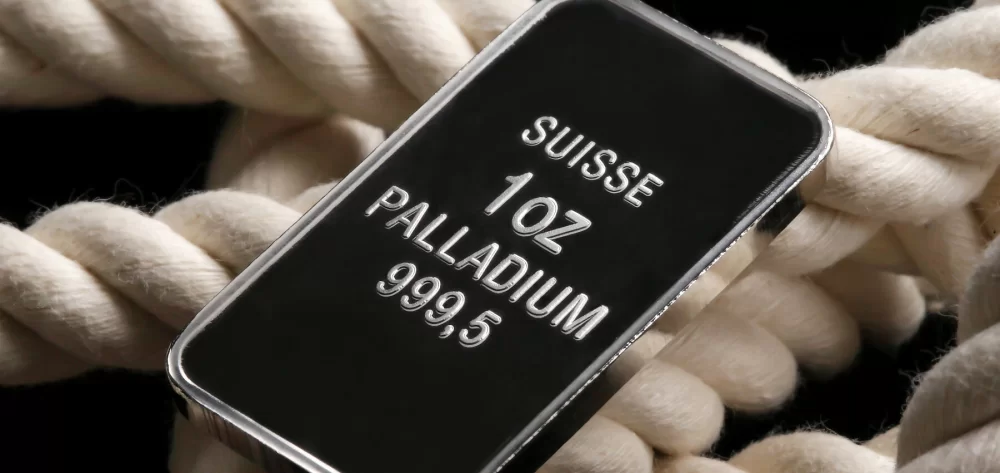1. Buy physical palladium
You can buy palladium bullion from numerous Swiss precious metal dealers and some Swiss banks. Palladium is most commonly sold in the form of bars, with coins playing a lesser role. Comparing the prices charged by different dealers before you buy is recommended.
Table 1: Prices of 1-ounce palladium bars at a selection of Swiss dealers
| Dealer |
Price |
Markup over the spot price as a percentage |
| Palladium spot price in CHF |
USD 1224/CHF 1075.41 |
|
| Basler Kantonalbank |
CHF 1259.01 |
17.07% |
| Geiger Edelmetalle |
CHF 1304.20 |
21.27% |
| Philoro |
CHF 1346.36 |
25.20% |
All prices include the Swiss value-added tax, as per August 29, 2023. The palladium spot price is based on the LBMA closing price on August 29, 2023. The USD/CHF currency exchange rate is from the same date.
An investment in physical palladium has a key advantage for people with low risk tolerance: There is no issuer risk because you own the asset yourself. The disadvantages of investing this way are that you pay VAT when you buy, and you have ongoing expenses in the form of storage costs. You also do not earn interest or dividends.
If you want to avoid paying VAT, then holding your palladium in a bonded warehouse can be a solution. However, the fees charged by the bonded warehouse may be higher than the costs of storing your goods in a bank safe deposit box or a safe.
2. Precious metal accounts
The biggest advantage of using one of the palladium-denominated precious metal accounts offered by many Swiss banks is that you do not need to worry about storage. Some banks give you the option of making withdrawals from your account in the form of physical bullion. The downside is that you pay ongoing account fees. The precious metal account comparison on moneyland.ch lets you compare accounts. You can find more information on this topic in the guide to Swiss precious metal accounts.
3. Palladium ETFs
Exchange-traded funds (ETFs) that invest in palladium can be a suitable investment option if you do not want to have to store physical palladium. These passive index funds aim to replicate the price of palladium as accurately as possible. You can easily buy shares in a palladium ETF using a custody account from a bank, or a brokerage account from an online stock broker. You can compare the brokerage fees and custody fees of Swiss trading platforms on moneyland.ch.
In addition to custody fees, you should also pay attention to the ongoing costs (the total expense ratio or TER) of the ETF itself. High costs can substantially shrink your returns. The table below provides a comparison of ETFs that are domiciled in Switzerland and denominated in Swiss francs. They are fully backed by physical palladium. You have the option of withdrawing palladium from the fund in standardized bars of approximately three kilograms per bar. Note that withdrawals are not a realistic option for many small investors, as the price of palladium is currently more than 100,000 US dollars per kilogram.
Table 2: Swiss ETFs that hold physical palladium and are denominated in CHF
| Exchange-traded fund |
ISIN |
TER |
5-year performance |
10-year performance |
| Palladium spot price in CHF |
|
|
19.08% |
60.97% |
| ZKB Palladium ETF AA CHF |
CH0183136065 |
0.50% |
16.39% |
52.90% |
Swisscanto ETF Precious Metal
Physical Palladium A (CHF) |
CH0106407239 |
0.63% |
13.70% |
29.46% |
The figures are based on prices on the first trading days of August 2013, August 2018, and August 2023. The palladium spot price is based on the LBMA closing prices on those dates.
4. Palladium ETCs
Exchange-traded commodities (ETCs) are another simple alternative to buying physical platinum. Like ETFs, an ETC can be bought and sold using a brokerage account. But a major difference between ETCs and ETFs is that ETCs are only debt claims against their issuer. If the issuer were to become insolvent, its assets would not be segregated like they would be with an investment fund, so the issuer risk is higher. You can minimize the issuer risk by using ETCs which are backed by physical palladium.
In Table 3, moneyland.ch gives you an overview of major palladium ETCs. These ETCs are denominated by US dollars, so figures have been converted into Swiss francs for clarity.
Table 3: Selection of ETCs backed by physical palladium
| Exchange-traded commodity |
ISIN |
TER |
5-year performance |
10-year performance |
| Palladium spot price in CHF |
|
|
17.52% |
57.41% |
| Invesco Physical Palladium ETC |
IE00B4LJS984 |
0.19% |
17.38% |
|
| BNPP Paladium ETC |
DE000PB8PAL7 |
0.99% |
12.30% |
|
| iShares Physical Palladium ETC |
IE00B4556L06 |
0.20% |
16.10% |
52.26% |
| WisdomTree Physical Palladium ETC |
JE00B1VS3002 |
0.49% |
15.33% |
49.86% |
Performance figures are based on prices on the first trading days of August 2013, August 2018, and August 2023. The palladium spot price is based on the LBMA closing prices on the same dates.
5. Palladium futures
Futures contracts make it possible to achieve high returns – or high losses – within short time frames. How it works: You create a contract in which you promise to buy or sell palladium to another party on a specific date in the future. Both the buyer and seller are betting on the future price of palladium, with the seller expecting the price to fall by the date in question, and the buyer expecting the price to go up.
Before you can trade with futures, you have to put down collateral to create a margin. Although the use of leverage in futures contracts makes it possible to earn high returns with very small capital outlays, futures are not recommended for new investors because the potential to lose money is very high.
6. Individual stocks in palladium-sector companies
You can also invest your money in companies that earn money by mining or dealing in palladium. Anglo American (United Kingdom) and Sibanye Stillwater (South Africa) are two examples of companies in the palladium business. You can buy shares in companies using a stock brokerage account. Investing in individual companies can potentially deliver high returns within short amounts of time, but the risk of shares losing value quickly is also high. Investing your capital in just a few companies is risky, so buying shares in individual stocks is not a suitable investment strategy for inexperienced investors.
7. ETFs that invest in palladium-sector companies
Stock ETFs that focus on companies in the palladium business are another solution for participating in the price of palladium, without investing directly in the metal. The money you invest in these funds is reinvested into a broad selection of different companies that mine, process, or deal in palladium. There are numerous ETFs that specifically invest in commodities and precious metal companies. The value of these ETFs is also significantly influenced by other precious metals, and not just the price of palladium. Important note: An ETF that invests in many different companies in the precious metal industry spreads the risk of loss much better than a portfolio with just a few individual stocks, but it is not broadly diversified because its investments are limited to just one industry sector.
More on this topic:
How to invest in gold
How to invest in platinum
How to invest in silver
Tips for buying physical silver




